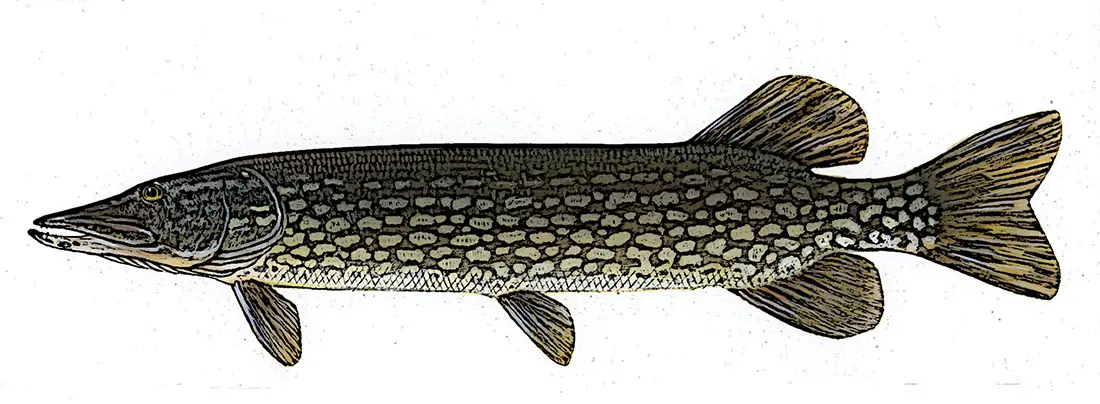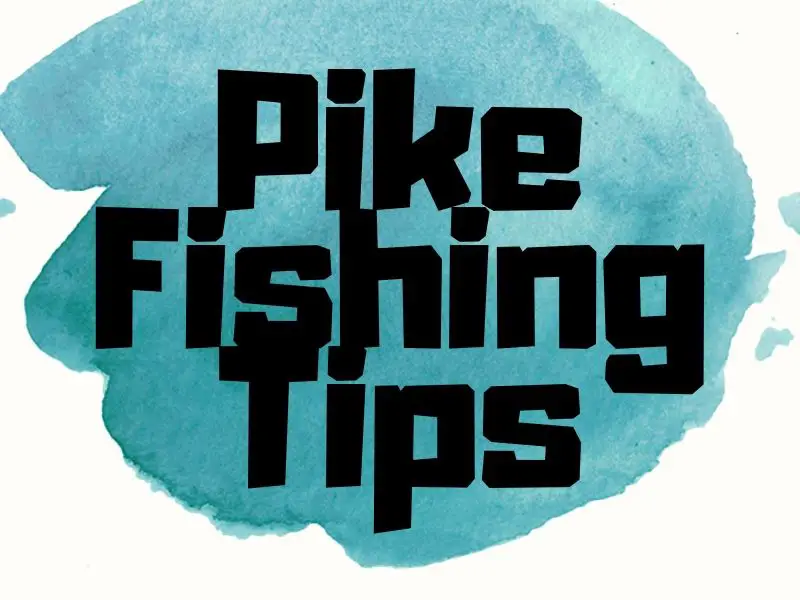Pike also known as northern pike, or notherns, are a popular fish to catch in northern parts of the world. They are commonly fished across the upper midwest United States and parts of Canada. Northern pike are known to go large in size, which makes them great for those fishing giant trophy-sized fish. They are one of the largest game fish you can catch in North America.
If you’re fishing for pike, we created this guide for you. Here we will cover how to identify northerns, where to catch them, the equipment you will need to catch them and give you a few bonus tips to help you catch more pike.
Northern Pike Identification
Northerns have a long somewhat torpedo-shaped body. They are generally muscular and have green colored tops and sides with a lighter colored bottom side. They have large mouths with duck-shaped snouts and are known to be quite slimy.

The average pike that you will catch in North America will weigh between 2 to 5 pounds. Though on a good day you may catch ones that weigh upwards of 15 pounds. European pike tend to grow larger than the fish in North America. The world record pike weighed a massive 55lbs.
Where to Catch Pike
Pike are found in slower-moving streams and shallow weedy lakes, reservoirs, and ponds. They can also be fished in rocky areas with cold and clear water. They like aquatic vegetation and prefer to stay in water around 60-65 degrees Fahrenheit.
Northern pike are an ambush predator. Look for them near weed beds and rocky areas with structure where they will be waiting to ambush their food. Most often you will find them in 2 to 15 feet of water.
What Do Pike Eat?
Pike aren’t very picky when it comes to eating. They mostly feed on smaller fish in the waters they inhabit. They commonly eat perch, sucker, and other smaller fish but will also eat frogs and any other creatures they can get their mouths on.
Seasonal Patterns
Fall
When the temperature starts to cool aquatic vegetation will start to turn brown and die. As the vegetation dies, it becomes a less likely spot for smaller baitfish, which means pike won’t be hunting there. The key to finding pike is finding spots where the vegetation stays green and healthy into the colder months. Some patches of water are directly in the sun, so they stay healthier longer.
You can also use a fish finder to search for fish activity near weeds, rocks, and ledges. If you can find baitfish in shallow water near structure where pike can wait to ambush, there is a good chance of hungry pike nearby.
Winter
Ice fishing for pike can be very productive if you have a little bit of knowledge about the lake you are fishing in. Depending on the area, pike can be found in almost any section of the water column. That is why some anglers will throw in as many lines as they are allowed at various depths when fishing winter northerns.
But you can greatly increase your success if you understand what the pike are feeding on in the water you are fishing. If the lake you are fishing has a lot of whitefish or tubilee, then you should be fishing open water areas for pike, because this is where they will be feeding at. If you are fishing a lake where the pike are feeding suckers or crappies, then fish deep weed beds and shoreline breaks.
The key is find the forage, you find the fish. It’s true for most species, and definitely holds true for pike.
Spring
In early spring your best chance is to look for bays that warm quicker than the surrounding water. Pike feeding activity tends to increase when the temperature reaches between 55 and 60 degrees Fahrenheit. By mid-spring when the waters are teeming with life you can find pike near their usual hangouts. Aquatic vegetation is your best bet, so look near the weeds.
Summer
When temperatures reach 70 degrees F in the shallows the pike will move into deeper waters where it stays cooler. Fish for them in waters ranging from 30 to 50 feet in depth where they will be escaping the heat. Look for rocky points and deep basins that are teeming with smaller baitfish. Trolling with crankbaits will be your most productive method for fishing large pike in the deep.
Best Time to Catch Pike
Pike are most actively feeding when the water temperature reaches around 65 degrees F. Early mornings to mid-mornings are the best, but about 1 hour after the sunsets you can also have a productive day.
Pike Fishing Equipment
Rods and Reels
A fishing rod around 7 feet in length with a medium-heavy action is a good baseline for pike fishing. Usually, you will be throwing heavier tackle, so you need a rod that can handle this. You can also opt for a heavy action rod if you know you are after huge fish and will be throwing heavy baits.
For pike fishing, you can use either a spinning rod or a baitcaster depending on what your preference is. Spinning rods are easier to use and work well for a variety of situations. Baitcasting rods and reels give you more control over casting distance and accuracy, and usually, generate more drag which can help you pull your lures out of the water much quicker.
Baits and Lures
Spoons
The wobble and flash of a good spoon lure can be irresistible to hungry pike. These lures have been used by anglers to slay pike for years and years, because they work. Use one around 4 to 5 inches in size. Typically slower retrieves work best. Pause and allow the lure to flutter and wobble to get the pike to follow.
Spinnerbaits
A spinnerbait can also be irresistible to pike in shallower waters. They work well even when the pike are in cover near weeds because most have a weedless design. Many anglers use large bass spinners for their pike fishing. Try chartreuse or white-colored spinners to get the most bites.
Topwaters
If you’re really after a thrill, try throwing topwaters to catch your monster pike. Toss walk the dog topwaters in the shallows near weed beds and rocks where the pike may be lurking. Slower retrieves tend to work best.
Jerkbaits
Jerkbaits can be another powerful lure option that you might want to include in your pike arsenal. Try to keep your bait suspended in the water column just above the level of the fish.
Crankbaits
If you’re after a larger pike, trolling deeper waters with a crankbait is probably your best option. These tend to work well in summer when the larger pike head to waters 30 to 50 feet deep to escape the heat.
Baitfish
You can use most smaller fish to catch pike, but what will work best is the fish they already used to eating in the waters you are fishing. Sucker, small whitefish, perch, and other baitfish tend to work well.
Fishing Line
You can use both monofilament or braided line for pike fishing. If you go with mono try to have at least a twenty-pound test line. For braided use a fifty-pound test. No matter which you choose, you need to have a leader. Wire leader or fluorocarbon will work fine, just make sure if you are using fluorocarbon it is at least an 80-pound test line. 12 to 18 inches of leader should get the job done.
Hooks
Treble hooks are popular because they do a good job of hooking and holding the pike. Use a treble hook around 2/0 or 3/0 in size. Some areas will often have a barbless hook rule for pike, so keep that in mind when fishing for them.
Tips on Catching Pike
Fish the Weeds
Pike tend to stay near aquatic vegetation so fishing near shallow weedy areas with a lot of smaller fish for them to feed on is your best bet. If it has a lot of aquatic vegetation, is in shallower waters, and is teeming with baitfish, there’s a good chance you’re gonna land pike.
Use a Leader
As we discussed earlier, you will definitely want to use a wire or fluorocarbon leader for pike fishing. They have very sharp teeth and are known to cut through lines pretty easily. 12 to 18 inches is all you really need.
Bright Colors
Pike are sight feeders so using brighter lures like white, orange, and chartreuse will make your lure standout in the waters better. Using larger and brighter tackle will help the pike see your presentation from further away and they will be more likely to give chase.
Related Posts:
Pickerel Fishing Tips
Muskie Fishing Tips
Sauger Fishing Tips
